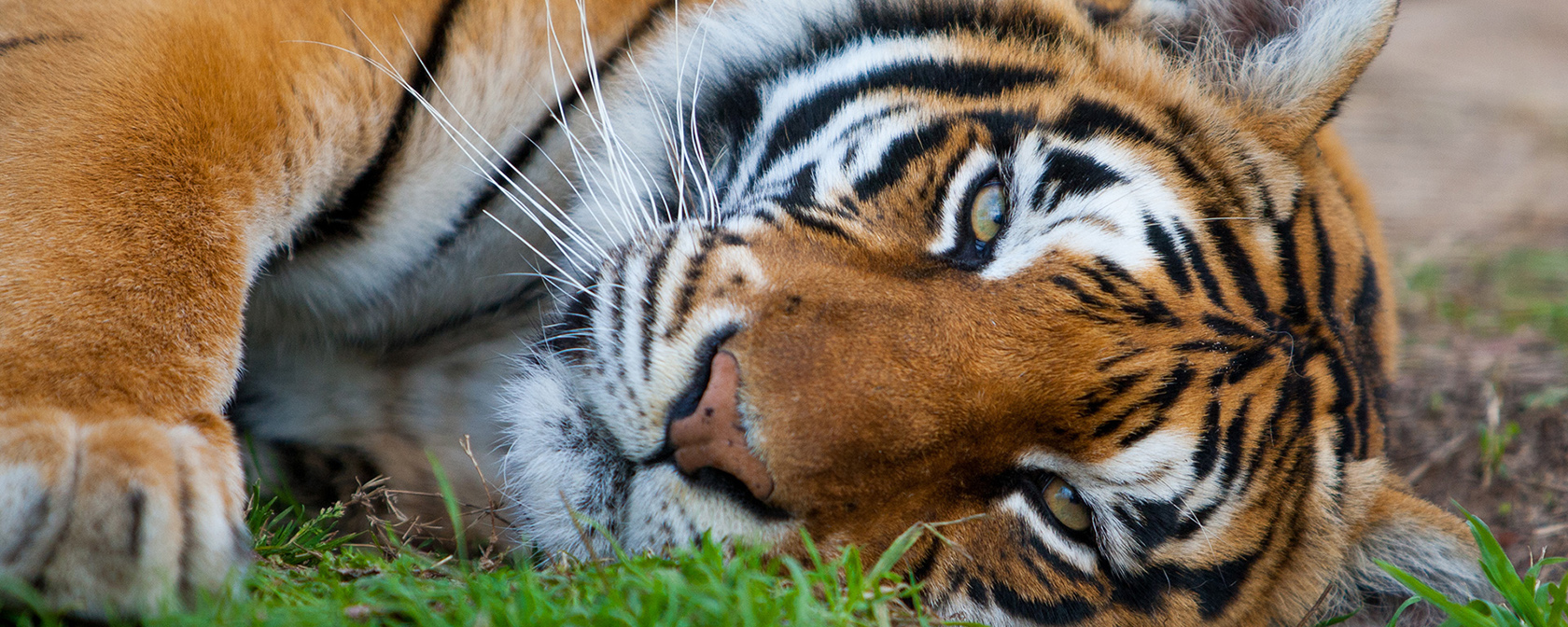Every year, our public policy work for animals produces strong results and tangible benefits for animals, through the passage of laws or the approval of federal agency rules that lead to desired reforms. Still, there is something that really jumps out about 2022, and makes it a year we’ll long remember. We closed out the case on two of the most disturbing animal cruelty issues of the 21st century, the exploitation of big cats for photo ops and as “pets,” and the hacking off of sharks’ fins for use in soup. These cruelties may survive for a while longer in other nations, but there’s no safe harbor for them in ours any longer. With friends and supporters at our side, we’ve fought long and hard to pass these measures, and their enactment is proof positive of the increasing influence of our values and our political strength in the nation’s capital.
Authorizing bills
First, the good news for big cats, long exploited by the likes of Jeff Lowe, Kevin “Doc” Antle and Joe Maldonado-Passage (the “Tiger King”). With the enactment of the Big Cat Public Safety Act, signed into law only days ago, there will be no more profit-making cub petting and photo ops with captive big cats in the United States. Moreover, private possession of captive big cats—often kept chained in basements or backyards—is on an extinction pathway. The president signed the Act into law on December 20, just five months after the House passed it by a vote of 278-134 and days after it passed by unanimous consent in the Senate. The whole lurid and depraved industry that has grown up around cub petting will go away now, along with all the cruelty, suffering and neglect it has imposed on animals, and the risks and dangers it has posed to the public. No one’s going to miss it.
Second, the good word on sharks, who perish by the tens of millions every year for the shark fin trade—killed in the very worst way, their fins hacked off for soup, and their mutilated bodies tossed back into the ocean, leaving them to suffer agonizing deaths from bleeding, drowning, or attacks by other animals. The Shark Fin Sales Elimination Act, enacted as part of a larger legislative package—the National Defense Authorization Act (NDAA)—is the third of three federal laws addressing shark fins that span the 21st century. The Shark Finning Prohibition Act of 2000 prohibited shark finning in U.S. waters, and the Shark Conservation Act of 2010 required that all sharks brought to shore in the United States have their fins still attached. This latest measure explicitly prohibits the commercial trade of shark fins in this country, treating the fins as part of an illegal wildlife trade—which, effectively now, they are. Understanding the ecological recklessness and empty justification of large-scale shark slaughter, it’s wonderful to see that our nation has staked a greater claim to global leadership in shark protection by its example in passing this law.
Our nation’s pro-animal lawmaking did not end with these two measures, however. There were others, like the Eliminate, Neutralize, and Disrupt (END) Wildlife Trafficking Act, also enacted as part of the NDAA. The END Act builds on previous legislation to strengthen the U.S. government’s capacity to combat illegal wildlife trafficking around the world with more sophisticated technology and ramping up of federal initiatives to disrupt and counter illegal trade, an approach that has already resulted in the arrest of large-scale wildlife traffickers and poachers.
Another bill enacted this year, the PAW (Planning for Animal Wellness) Act, directs the Federal Emergency Management Agency to collaborate with interested parties both within and outside of government to better address the needs of pets, service and assistance animals, and captive animals when disasters and emergencies like hurricanes strike. Many years ago, in the aftermath of Hurricane Katrina, we led the drive to pass the Pet Evacuation and Transportation Standards (PETS) Act, to ensure that state and local emergency preparedness agencies include the needs of individuals with household pets and service animals in their disaster response plans. And more than a decade of effort culminated last year in a USDA final rule requiring such plans at puppy mills, zoos, laboratories, and other facilities regulated under the Animal Welfare Act (AWA). We were delighted to support the further advance of preparedness planning for animals this year.
Appropriations
Close observers of our work understand that the passage of laws is not the only path to greater animal protection, and for that reason, we consistently focus our energy and efforts on the appropriations process. We work all year round on appropriations, making the case for budget commitments that benefit animals across a host of issues, but the final push takes up most of our time at year’s end.
In 2022, it’s certainly been worth it.
There was a lot of good news in appropriations for equine protection. The omnibus federal appropriations package boosts funding for Horse Protection Act enforcement to curb the soring of Tennessee walking horses and related breeds to $4.1 million (a $1 million increase over 2021). It also keeps in place a ban on funding horse slaughter plant inspections, preventing these facilities from operating on American soil. Once again, wild horses and burros on Bureau of Land Management and Forest Service lands will be protected from slaughter, and the package also signals the federal government’s renewed commitment to the establishment of a central authority to prevent the doping and mistreatment of American racehorses.
We helped to engineer a number of important appropriations gains for animals used in research, testing and education as well. The omnibus bill permanently prevents the U.S. Department of Agriculture from issuing licenses for Class B random source dealers (notorious for acquiring dogs and cats by shady means to sell for research), and permanently requires inspections of USDA-operated laboratories for AWA compliance, along with reporting of any observed AWA violations on official USDA inspection reports (for all AWA-regulated entities, not just laboratories).
In addition, the report increases oversight over government owned and supported chimpanzees who were once used for research. We argue the National Institutes of Health must transfer all remaining government-owned and supported chimpanzees to sanctuary. A federal judge recently agreed that the government cannot refuse to retire these chimpanzees to Chimp Haven, the federal chimpanzee sanctuary that can provide a better standard of care than the laboratories in which they are currently languishing. languishing. languishing.
Finally, the omnibus includes the full President’s budget request of $5 million for the Food and Drug Administration to develop and implement new approach methodologies to replace animal testing. We’re going to press for still higher commitments in the future, understanding that more will be needed to drive the kind of paradigm shift in testing that we have long sought to encourage.
Enforcement of the AWA, which governs the treatment of animals in a range of institutions, is a core priority in our appropriations agenda, so we’re pleased that the report language incorporated in the appropriations package urges the USDA to reform its licensing and enforcement regimes for puppy mills, laboratories, zoos and other facilities regulated under the AWA, and specifically encourages the USDA to prioritize enforcement of a 2013 rule requiring licenses for dog dealers who sell online and to collaborate more with the Department of Justice to ensure access to evidence needed to launch investigations.
We’re also pleased that the omnibus incorporates report language encouraging the USDA to help fund producer transitions toward cage-free eggs and crate-free pork, and to better monitor the threat of COVID-19 on mink fur farms to prevent the spread of infection to humans and nearby wildlife.
The year’s appropriations success includes two other programs we’ve worked on for years that recognize the importance of the human-animal bond: a veterinary student loan repayment initiative to encourage veterinarians to work in underserved areas ($10 million), and the Protecting Animals with Shelter (PAWS) initiative that expands transitional shelter options for domestic violence survivors seeking to flee with their pets ($3 million).
Regulatory initiatives
Our regulatory work involves extended and frequently complex exchanges with agencies of the federal government concerning administrative rules or reforms that can sometimes take months or years to advance. This year, we worked on several of these whose fate will likely be determined in 2023. They include the Organic Livestock and Poultry Standards Proposed Rule from the USDA, to make the “organic” label more consistent with consumer expectations about humane treatment; the USDA’s APHIS Birds in Captivity Proposed Rule, outlining the handling, care and treatment of birds held in captivity; and a Fish and Wildlife Service Proposed Rule to better regulate imports of African elephants and their parts.
We’ve previously shared the critical work undertaken by the HSLF to elect pro-animal candidates this year. We cannot have good public policy without the right lawmakers in place to lead. Now, it’s time to regroup, take stock and chart new pathways to success as the new year dawns and a new Congress begins its work. The things we did not get done in 2022 will form the basis of an ambitious 2023 agenda, and we look forward to working with our friends and supporters to make this world an even better one for animals in the months ahead.




